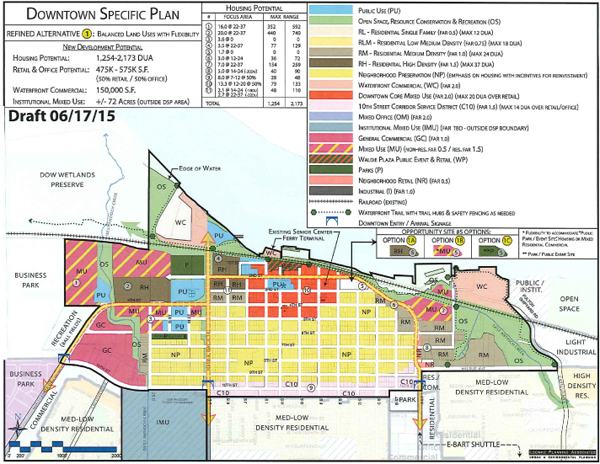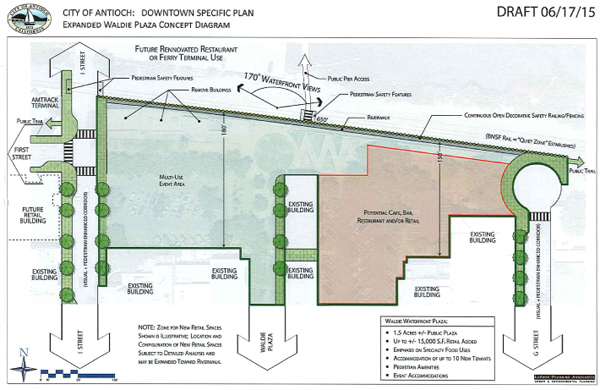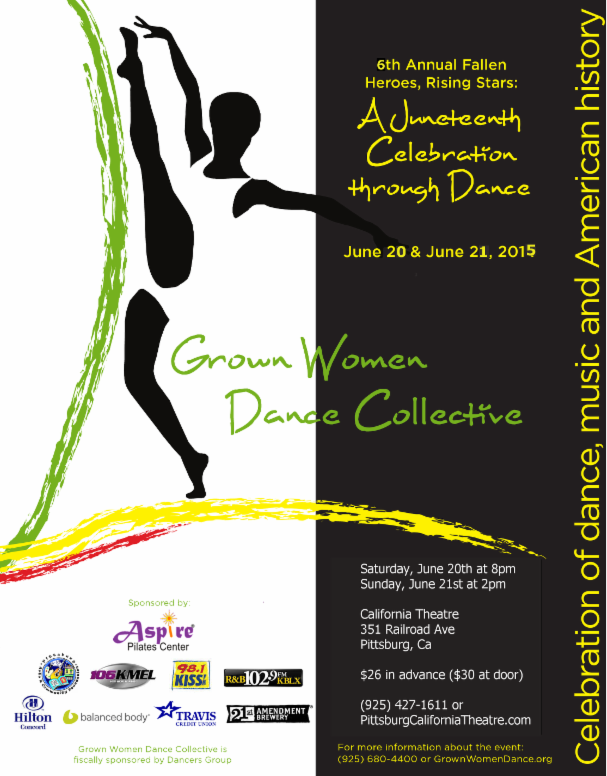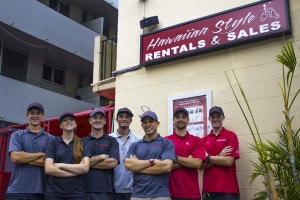
Downtown Specific Plan Refined Alternative 1, Attachment B, which includes three options for the former Antioch Lumber Company lot.
Consultant offers alternative with downtown park, event center, at the request of Ogorgchock, Rocha and Harper
By Allen Payton
Now is the time for interested residents and business owners to provide input to the City Council before they take their vote on the preferred plan for Antioch’s historic downtown Rivertown area, Tuesday night’s council meeting. Comments can be sent either by email to Mayor Harper and Council Members, or by phone calls or by speaking at the meeting, during public comments on the agenda item number 10.
The study session held by the Council, Planning Commission and Economic Development Commission on Tuesday, June 2 was standing room only, with a variety of residents and business owners sharing their thoughts and concerns with the plan. The majority of comments and applause were about having a downtown park and event center, specifically located at the old Antioch Lumber Company yard property. The lumber company was owned by Henry Beede and his family.
The lot, which has been owned by the city since the late 1990’s, bordered by West Second, West Third and F Streets, has been planned for multi-family housing of condominiums or townhouses, or a mixed-use development with retail, commercial and residential uses, during that time.
Ever since the city replaced the Barbara Price Marina Park with the new boat launch facility, downtown residents, represented by the Rivertown Preservation Society, whose president is former Antioch School Board Trustee Joy Motts, have been pushing for an event center on the lot, instead of housing.
The Celebrate Antioch Foundation, lead by Chairman Wayne Harrison, has taken the lead on the effort, submitting a rendering of a proposed event center. The non-profit organization has been organizing Antioch’s July 4th celebrations for this year and the past two years, as well as last December’s Holiday Delites Parade and Christmas Tree Lighting Ceremony.
While most speakers weren’t opposed to additional, upscale housing in downtown, to bring more people to the area who would shop and dine in the area’s stores and restaurants, some speakers said they don’t want any housing.
Residents, business owners offer their thoughts
“Who wants high density between Second and Third Streets, where there are the vest views of the river?” asked downtown homeowner Latasha Wallace, to loud applause. “We want a farmer’s market. We want car shows. We want concerts, again. We don’t want more people downtown.”
“It is beyond reason why staff has not listened to the public,” said Motts. “Over one thousand signatures have told you not to put housing on the Beede lumber site. Celebrate Antioch Foundation has proposed an event center plan.”
“Help us create something special,” she implored.
Downtown business owner and Celebrate Antioch Foundation board member Jim Lanter shared his thoughts.
“We think too small,” he stated. “I’ve lived in downtown for 30 years and have had a business for 15 years. We need another place to stage events. I don’t think anyone talked to any retail business owners in downtown.”
“We can bring thousands of people to downtown, if we create 10 to 12 events a year,” Lanter continued. “We just need the opportunity and the place to do it. Please help us.”
Former Councilwoman Liz Rimbault offered a historical perspective.
“In the 1990’s the CRAWDADS defeated a development on the site,” she shared. “It’s taken us decades to reclaim some of our water front for the benefit of our citizens.”
“Let’s not forget the high-pressure pipe placed underneath that lot. It pumps poop to 7A District,” Rimbault added.
One neighbor shared her thoughts.
“I live across the street from the Beede Lumber site. I oppose the petition for a residential development because we’re in a serious drought, not to mention the lack of law enforcement.”
Lucy Meinhardt supported both housing and an event center.
“I have a compromise,” she said. “Go for the most quality of life for all Antioch citizens. I am not opposed to a condo-type housing downtown. But, if we built one of those medium-density down by the marina. Give it time. See if the enhancements bring people to downtown. Just try and see what happens.”
“A really important question is ‘who is it for, to increase revenues to the city through property tax or enhance the community that exists there, right now,” Carol Kuhn asked. “If it’s all about the money, I think it’s a mistake to think that way.”
“Bring a higher quality of life up in priority,” she added. “Don’t worry about the money. The money will follow.”

Downtown Specific Plan, Expanded Waldie Plaza, Attachment D
Commissioners and Council Members ask questions, make statements
Commissioners and Council Members then asked their questions of the city’s consultant, Dick Loewke of Loeweke Planning Associates.
Economic Development Commissioner Joseph Adebayo asked him how he rated each of the three alternative downtown plans for economic and quality of life.
“The quality of life issues are paramount, regardless of the plan,” Loewke responded. “Alternative 2 runs out of gas in five to 10 years. We tend to favor flexibility…”
He favored Alternatives 1 and 3, and it is those plans, with modifications and three sub-plans which are included in the staff report for Tuesday night’s council meeting agenda.
Loewke then added comments about “the importance of corridors that lead to downtown, L Street in particular. But A Street, as well.”
The issue of crime was broached.
“A lof of people were concerned about crime. How will the high-density housing affect that?” asked Economic Development Commissioner Josh Young. “My family has been in the town for over 100 years. Beede Lumper was my uncle Frank’s business. I would like to see the lumber yard develop into a park.”
Loewke responded, “Crime has correlated into vacancies and deterioration. You have a spiraling downward. The crime issue is more of an issue of a lack of people presence.”
Another Economic Development Commissioner, Ken Turnage asked about the type of proposed housing.
“Is the housing medium- to high-income?” he asked. “If you’re going to bring money downtown, it has to be affluent people.”
Loewke agreed.
“We want to bring as much disposable income to downtown,” he stated. “To support business activity, that would be ideal.”
Planning Commissioner Keith Archuleta offered his perspective.
“What we’re looking for is balance,” he said. “I don’t see this an either or. We need foot traffic, downtown and consistent traffic. Events won’t be enough.”
“It’s about what the market will support, over time,” Loewke responded.
Parsons wants to see action
“What I want to see come out of this is action…now,” Planning Commissioner Martha Parsons stated emphatically. “Entrances into downtown, A Street needs landscaping. L Street needs a total revamping.”
Planning Commissioner Kerry Motts spoke in favor of a park on the lumber company lot.
“A part at Second and Third provides a grand entrance to Rivertown,” he said. “It should be designed as a park.”
“Celebrate Antioch has offered to build his park with no costs to the city,” he added. “Alternative 3 is preferred.”
The council members then shared their thoughts.
Ogorchock pushes for alternative with a park
“If we truly are listening to the community, is there a reason we didn’t have Alternative 4 that includes a park at the lot?” asked Mayor Pro Tem Lori Ogorchock.
“It can be easily added to any of these alternatives,” Loewke responded.
“The parking lots need to bmoved to the outside of downtown,” Ogorchock stated. “We need low- to medium-density housing in downtown.”
“I want you to talk about transit-oriented and walkable and bicycle-friendly communities,” Councilwoman Monica Wilson said.
“Those are excellent ideas to include in any plan for downtown,” said Loewke. “This is a theme that needs to weave into the plan.”
He spoke of the three corridors that lead to downtown, Auto Center Drive, L Street and A Street.
“One of the ideas is a shuttle system to the eBART station to bring people to the downtown and back,” he added. “Part of the General Plan is the circulation element, which includes bicycles.”
Wilson also mentioned the need for “renovations of some of our older buildings.”
“Some require earthquake retrofit of unreinforced masonry buildings,” she added.
Councilwoman Mary Rocha said she supports “a fourth proposal, too, including a park.”
“Now, we’re going to have to work together to finance this,” Rocha added.
Councilman Tony Tiscareno kept it brief, in support of additional housing, downtown.
“We need the population, the folks to come in to have the businesses,” he stated.
Loewke offered additional comments on the alternative proposals presented at the June 2 meeting.
“These alternatives were not intended to be one better than the other two,” he stated. “I tend to favor Alternatives 1 and 3 over 2 because it give you flexibility.”
He also said that “Alternative 1 has the greatest potential to support” a ferry terminal.
“Getting people down there, keeping them down there, and the answer is move forward on all fronts,” he dded.
Harper said he wants “to come up with a plan we can all support to make this city better.”
“As we consider adding more crime prevention through environmental design, proper lighting, proper landscaping, more accessiblity to police, small gathering places,” he continued. “I will support the two council members for a fourth alternative looking at the Beede lumper lot for a park.”
Duran offered his final comments to wrap up the meeting.
“Retail follows residential,” he shared. “There’s a direct correlation between the density of the residential and the vibrancy of the retail.”
To see the complete council meeting agenda and staff report, for Tuesday night, June 23, please click here. See item 10 and click on Staff Report.
Antioch Council meeting will begin at 7:00 p.m. in the City Council Chambers, between West Second and Third Streets in downtown, or can be viewed on Comcast Channel 24 or via live stream video on the city’s website by clicking here.




























